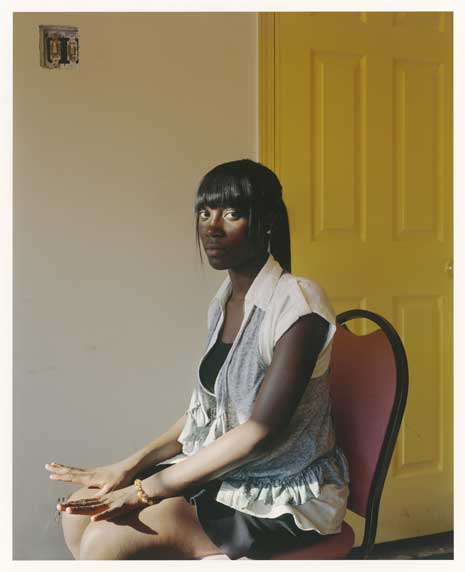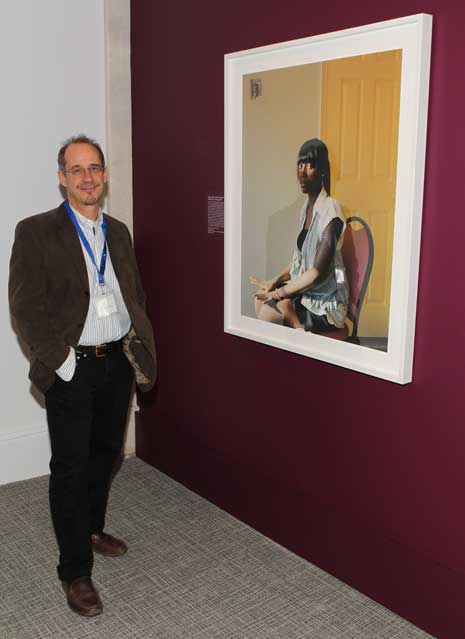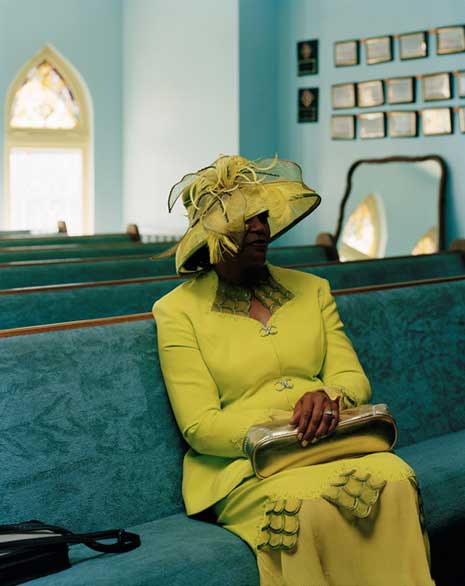Portrait of an Artist: Paul D’Amato
This is a continuing series of interviews with the forty-eight artists whose work was selected for the Outwin Boochever Portrait Competition. The third OBPC exhibition opened on March 23, 2013, and will run through February 23, 2014.
Paul D’Amato, who participated in our interviews last autumn, was named a commended artist of the 2013 competition.

Q: What is your name, where are you from, where do you live now?
A: Paul D’Amato. I’m from Boston, went to college in Oregon, and now live in Chicago
Q: What medium(s) do you work with?
A: I’m a photographer who still works with film and the amazing range of cameras that film allows, principally a 4 x 5 view camera or a 6 x 7 handheld rangefinder. I make work-prints in the darkroom because it’s fast and gives me an idea of how the light wants to be in the final print. Then for images I know I’m truly interested in, I scan the negative and print digitally.
Q: Tell us about your technique/creative process.
A: My creative process involves throwing myself into communities that aren’t technically where I live—that is, if we abide by narrow geographic definitions of where we live. But I consider the whole country, the planet even, to be where I live—I’m part of all of it and responsible to varying degrees for many aspects of it.
“For as the body is one, and hath many members, and all the members of that one body, being many, are one body” (1 Corinthians). My creative process begins with truly believing that. That belief is my passport. After that my job is to honor that experience with all the things that inspire me as an image-maker. We’ll get to that later.
Q: What is your background (education, career, etc.) and how does it contribute to your art?
A: Three things from my past shape my values as an artist.
1. My working-class family’s interest in politics, education, and the all the arts—musical, literary, and visual.
2. The value placed on the humanities at Reed College, where I received my BA.
3. What I learned from having to travel cross-country either by hitchhiking, hopping freight trains, or cramming in a car for days with other students who couldn’t afford to fly all the time between the West and East Coast. I learned to talk with anyone and everyone and to quickly read people I’ve just met. I learned, too, that everyone has a story. Not only was this something that was a perfect antidote to any kind of elitism that may have been festering from the schools I attended, but these lessons and skills are things I use every day I photograph.
After that, I’d say that attending Yale for my MFA, where we heard more about Robert Frost than anything about career, where the emphasis was on how an image worked rather than how it would work in the art market. And too, my students at Columbia College, where it is such a pleasure to teach and have people interested in what’s taken me a lifetime to know.

Q: Tell us about the piece you submitted to the competition.
A: The portrait of Lillian was made in a church on the west side of Chicago in a nondescript function room off of the sanctuary. I was principally interested in Lillian’s friend, who I had arranged near the room’s large windows facing the street. Lillian was just off to the side waiting for her turn in the spotlight. But then I noticed that where she was, against that yellow wall, getting only part of the direct sunlight coming into the room was, in fact, a lot more interesting than what I had arranged.
I noticed too that she, Lillian, at that moment looked a lot more striking than her friend who was more conventionally beautiful. I told her to stay where she was and then, between poses that we were inventing together, she stretched her fingers to relieve some of the tension from being paid so much attention to. I asked her to do that again which, in the end, restored some of the tension that had charged the whole collaboration to begin with.
All of it—the picture and everything leading up to it—was the result of looking outside of conscious intention. For me, it’s the things just to the left or right of preconception that is always more interesting than what I hope to do or find.
Q: Tell us about your larger body of work.
A: The portrait of Lillian comes from a larger body of work that I have been working on for the last eight years on the west side of Chicago called HereStillNow. It’s a community like a lot of communities in every urban area of the country—African American and poor—that thousands of people drive through, drive around every day of the year. There’s a tacit acceptance that this is the way it is and that it will probably always be that way.
And sure enough, through the last Bush administration and the first term of President Obama, very little has changed here. These communities are the collateral damage of capitalism, and even though I know that I can’t change the economics that perpetuate this, I feel strongly that there is inherent value in paying attention. I want every one of my photographs to show that each of my subjects is as important as any that have ever been seen in art.
Q: What are you currently working on?
A: I’m trying to edit and sequence the thousands of pictures I have made here since 2004 into a coherent body of work. The project is composed largely of portraiture, but there are also many detail images and the occasionally larger view of things that set the stage for everything else. I am also in the process of collecting written statements from my subjects, from the pastor of the Original Providence Baptist Church, and from writers outside the community as well.
My hope is that, taken all together, there will emerge a sense of how collaborative and multifaceted the process of imaging this community has been. A large survey of this work with an accompanying catalogue will be at the DePaul Art Museum next September.
Q: How has your work changed over time?
A: As I have gone from photographing with a 6 x 7 (mostly) handheld range finder to the much slower way of working necessitated by a view camera, my work has gone from being candid and intuitive to being a lot more collaborative, thoughtful, and deliberate.
The work has also grown from seeing my subjects as part of a perpetual human theater to seeing them as all having a unique psychological presence. Instead of having the sense of how someone feels by the way they act, you now have that sense by the way they look at the camera, by the way they hold their hands, by the way the light amplifies a certain shift in mood and makes visible what is essentially impossible to truly know from a picture.
Q: Who is your favorite artist?
A: I don’t have a favorite artist; I’d be surprised if anyone could say they did, since there are so many that we collect along the way. What I have done over the years is found my tribe. And I bet if they were all able to be in the same village that they’d all get along or fight like brothers and sisters. They would all know that they’re up to the same game and either collaborate or compete.
This tribe would include lots of painters, who early on were my principal inspiration, painters like Francisco Goya, Caravaggio, Richard Diebenkorn, Bruegel, Jackson Pollock, and Jasper Johns and photographers like Helen Levitt, George Brassai, Josef Koudelka, and Larry Sultan.
All of that sounds kind of highbrow, but if I’m going to be truly honest, I’d say that what has always inspired me is the music I grew up with, and that starts with the Beatles, the Who, the Stones, the Band, Miles Davis, the Clash, Bob Dylan, Aretha Franklin, Joni Mitchell, John Coltrane, Richard Thompson, the Allman Brothers, Charles Mingus, Louis Armstrong, and Hank Williams. I’m fairly sure that Goya would love the Clash and be a huge fan of Fellini and Truffaut too.
I have a favorite living artist and it’s the one I live with, Anne Harris, who is also in the show, and who every day comes in the house smelling of oil paint, reminding me that if I don’t have the patience to be a painter then at least I can be around her and we can do all of this together.
Q: If you could work with any artist (past or present) who would it be?
A: Hanging with Brassai in Paris during the thirties has always been a fantasy, but then again being with the Beatles when they were recording Revolver and Rubber Soul would be tough to beat, too. The only down side is that I wouldn’t be able to call my wife and tell her what I did that day because she would be only four years old.
Q: What inspires you?
A: To be in awe, which is a feeling that is best defined as a moment that makes you forget everything about yourself. To stand in front of someone, or something, or to be in a situation and have that feeling and be conscious only of the need to honor that moment with the best picture I’m capable of.
